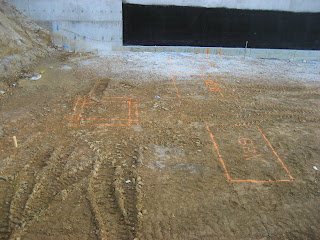10/27/08
7:45 am
7:45 am
40 degrees
overcast & windy
View at entry looking south-east.
Fireproofing installed at gymnasium (1st floor to roof). Framing installation at south complete, framing in progress at north. Roof drain installation in progress at gymnasium and second floor north. Fire extenguishers installed around first floor. Temporary protection of steel structure at roof east and south.
Retaining wall at south-east (adjacent to mechanical room) - installation complete. A Hydro-hi-tech raising scaffold.
In talking with one of Construction Management staff I learned about site safety and weather planning. I asked about the effect of cold weather on working - there were weather reports that called for snow flurries. I was told the snow flurries wouldn't impact the schedule this week because it was not very severe. But the schedule includes a couple of days this time of year to account for inclement weather. The only work affected by the extreme cold is the exterior stone cladding work. Even that is slowed by much. The water for the mortar mix can be heated and the work can proceed. I was also told that eventually they may have to provide temporary enclosures for the work, to which I asked if the extenguishers were a part of that plan. I was then informed that the extenguishers were an Occupational Safety and Health Act (OSHA) regulation.
I got to watch a worker drill through the second floor slab at the south-west. What the photo does not show, and what I learned by watching and talking to the guy, is that he set up a tarp below to catch the steel decking as it fell through and protect the material being stored below.



























